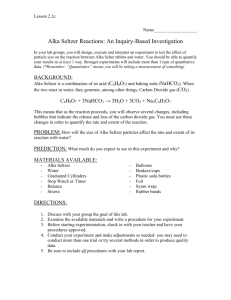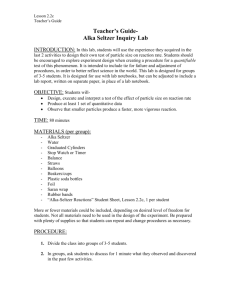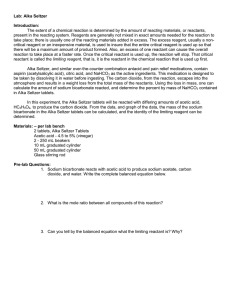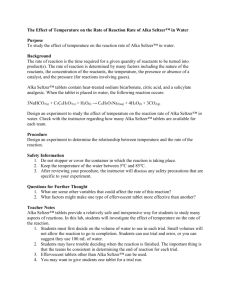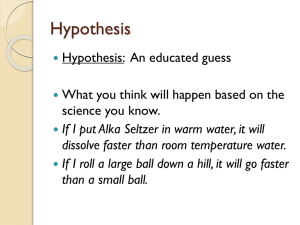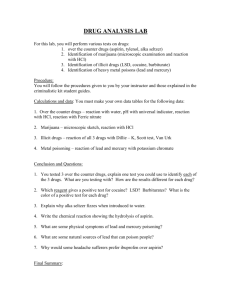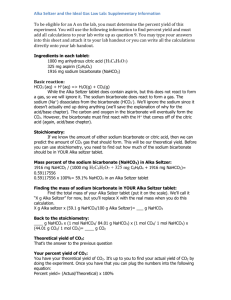Alkaseltzer Lab
advertisement
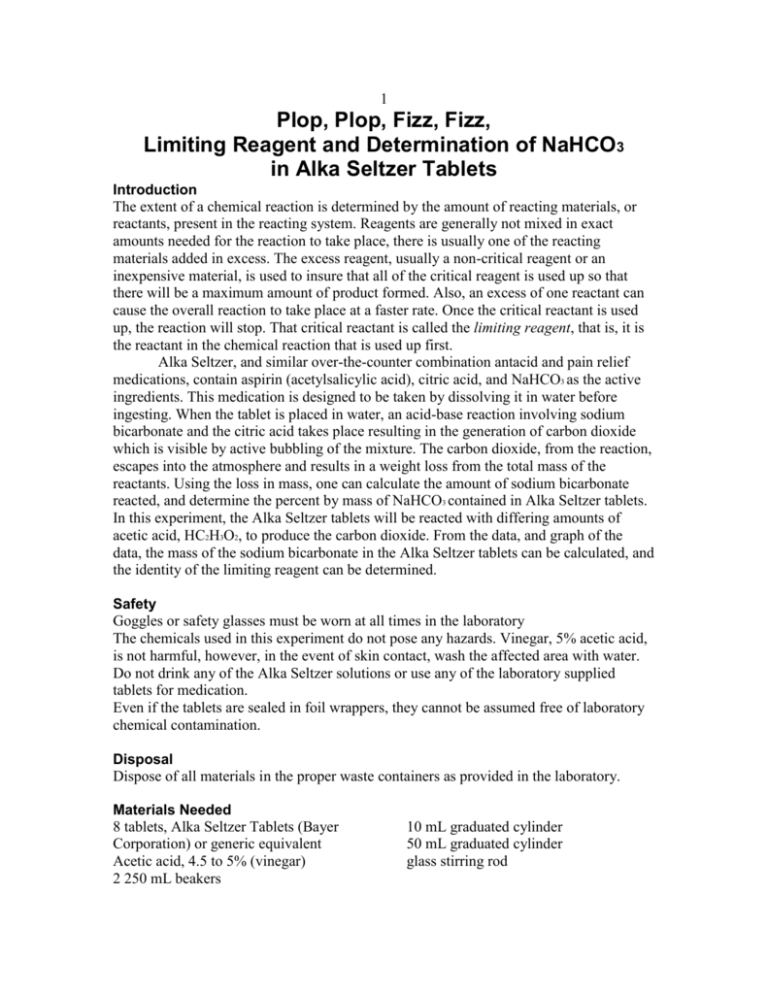
1 Plop, Plop, Fizz, Fizz, Limiting Reagent and Determination of NaHCO3 in Alka Seltzer Tablets Introduction The extent of a chemical reaction is determined by the amount of reacting materials, or reactants, present in the reacting system. Reagents are generally not mixed in exact amounts needed for the reaction to take place, there is usually one of the reacting materials added in excess. The excess reagent, usually a non-critical reagent or an inexpensive material, is used to insure that all of the critical reagent is used up so that there will be a maximum amount of product formed. Also, an excess of one reactant can cause the overall reaction to take place at a faster rate. Once the critical reactant is used up, the reaction will stop. That critical reactant is called the limiting reagent, that is, it is the reactant in the chemical reaction that is used up first. Alka Seltzer, and similar over-the-counter combination antacid and pain relief medications, contain aspirin (acetylsalicylic acid), citric acid, and NaHCO3 as the active ingredients. This medication is designed to be taken by dissolving it in water before ingesting. When the tablet is placed in water, an acid-base reaction involving sodium bicarbonate and the citric acid takes place resulting in the generation of carbon dioxide which is visible by active bubbling of the mixture. The carbon dioxide, from the reaction, escapes into the atmosphere and results in a weight loss from the total mass of the reactants. Using the loss in mass, one can calculate the amount of sodium bicarbonate reacted, and determine the percent by mass of NaHCO3 contained in Alka Seltzer tablets. In this experiment, the Alka Seltzer tablets will be reacted with differing amounts of acetic acid, HC2H3O2, to produce the carbon dioxide. From the data, and graph of the data, the mass of the sodium bicarbonate in the Alka Seltzer tablets can be calculated, and the identity of the limiting reagent can be determined. Safety Goggles or safety glasses must be worn at all times in the laboratory The chemicals used in this experiment do not pose any hazards. Vinegar, 5% acetic acid, is not harmful, however, in the event of skin contact, wash the affected area with water. Do not drink any of the Alka Seltzer solutions or use any of the laboratory supplied tablets for medication. Even if the tablets are sealed in foil wrappers, they cannot be assumed free of laboratory chemical contamination. Disposal Dispose of all materials in the proper waste containers as provided in the laboratory. Materials Needed 8 tablets, Alka Seltzer Tablets (Bayer Corporation) or generic equivalent Acetic acid, 4.5 to 5% (vinegar) 2 250 mL beakers 10 mL graduated cylinder 50 mL graduated cylinder glass stirring rod PROCEDURE 1. Measure 35 mL of water into a 250 mL beaker. Weigh the beaker and water and record the mass. 2. Weigh and record the mass of an Alka Seltzer tablet. 3. Place the Alka Seltzer tablet into the water in the 250 mL beaker. 4. When the bubbling has ceased, stir the solution to ensure complete dissolution of the tablet and to remove any visible bubbles of carbon dioxide. Gently tap the stirring rod against the inside of the beaker to remove anydrops of liquid before weighing the beaker and its contents. 5. Weigh the beaker and its contents. Record the mass. 6. Dispose of the solution in the beaker as instructed. Wash the beaker and rinse it with distilled or deionized water. 7. Repeat the experiment using 5 mL of acetic acid (vinegar) and 30 mL of water in the 250 mL beaker. NOTE: once the reaction has started, you may use a second 250-mL beaker to run the next trial in the experiment. You can continue to alternate beakers, running the additional experiments in simultaneous, but staggered trials. Be sure to keep track of the mass of each beaker used, as the exact mass of each beaker is different. 8. Repeat the experiment a third time using 10 mL acetic acid (vinegar) and 25 mL of water in the 250 mL beaker. 9. Continue to repeat the experiment 5 more times increasing the volume of the acetic acid by 5 mL and decreasing the volume of water by 5 mL for each new trial as indicated in Table 1 Table 1. Composition of reaction solutions Exp. No. 1 2 3 4 5 6 7 8 Volume of acetic acid, mL 0 5 10 15 20 25 30 35 Volume of Water, mL 35 30 25 20 15 10 5 0 CLEAN UP Clean up all glassware with soapy water. Rinse well before returning it to the cabinet. Clean up your work area. Discard all papers and wrappers from the Alka Seltzer in the trash. CALCULATIONS AND RESULTS Write the balanced chemical equation for the reaction of Alka Seltzer (NaHCO3) and acetic acid (HC2H3O2). Calculate the mass of carbon dioxide generated for each of the trials. Calculate the mass of NaHCO3 reacted for each of the trials. Calculate the percent by mass of NaHCO3 in each tablet of Alka Seltzer. Calculate the average percent of NaHCO3 in the Alka Seltzer tablets. Identify the limiting reactant in this exercise. How did you know that it was the limiting? REFERENCE Chen, Yueh-Huey, and Jing-Fun Young, Alka SeltzerFizzing – Determination of Percent by Mass of NaHCO3 in Alka SeltzerTablets, J. Chem. Educ., 79, (July 2002), 848-850.
